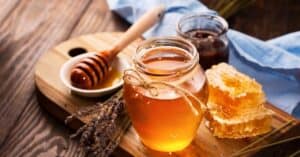Many states in the United States have a state animal. Some have a range of different types of animals, from state birds to state insects. West Virginia is no exception. Let’s take a look at what the West Virginia state insect is and why it is such an important organism. You might be surprised by what it is!
What is the West Virginia State Insect?
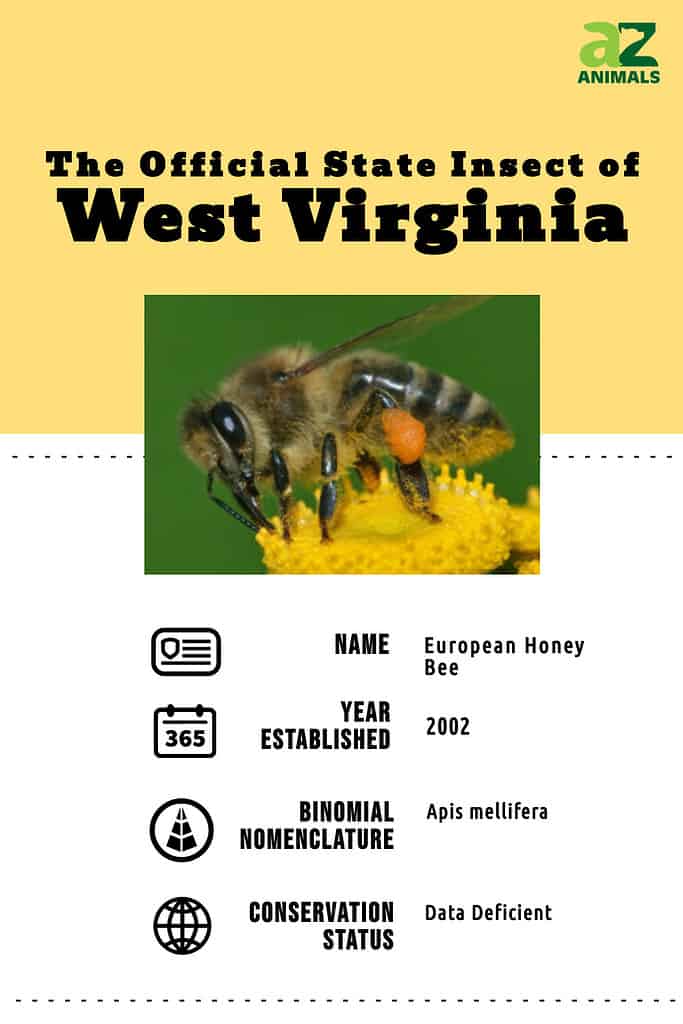
The West Virginia state insect is the European honey bee or Apis mellifera. The unique insect species is essential to ecosystems all across the world. These bees are native to Europe, but because of how beneficial they are to agriculture and biodiversity, they have been brought to other continents. They are significant pollinators who ensure the reproduction of several plant species, therefore their importance goes much beyond their capacity to generate honey.
Pollination is one of the most critical roles played by European honey bees. They move pollen grains from the male reproductive organs (anthers) of flowers to the female reproductive organs (stigma) as they search for nectar and pollen, assisting fertilization and subsequent seed and fruit formation. The sexual reproduction of flowering plants, such as many crops used to produce food for humans, depends on this mechanism. Honey bees are said to be responsible for pollinating 80% or more of the world’s blooming plants, including fruits, vegetables, and nuts.
The Value of Honey Bees
Honey bees are crucial to the agriculture sector’s ability to successfully pollinate crops. Their tireless effort boosts agricultural yields, enhances fruit and seed quality, and maintains the variety of plant species. The productivity and profitability of farming systems would be seriously hampered in the absence of honeybees. Just as well, honey bees help preserve natural ecosystems by pollinating blooming plants and wildflowers, which keeps these habitats’ biodiversity and general health high.
Also, European honey bees play a significant role in ecological interactions and food chains. By supplying other creatures with necessary food supplies, such as birds and animals, their pollination actions help to ensure their survival. In this manner, honey bees support the complex web of life in ecosystems and aid in preserving a delicate equilibrium.
However, the European honey bee population confronts a number of difficulties, such as illness, pesticide exposure, habitat loss, and climate change. The stability of ecosystems and sustainable food production depends on actions taken to preserve and protect these vital pollinators. We can contribute to the protection of the European honey bee and the habitats it depends on via education, conservation efforts, and ethical land management techniques, thus promoting a better and more resilient earth for future generations.
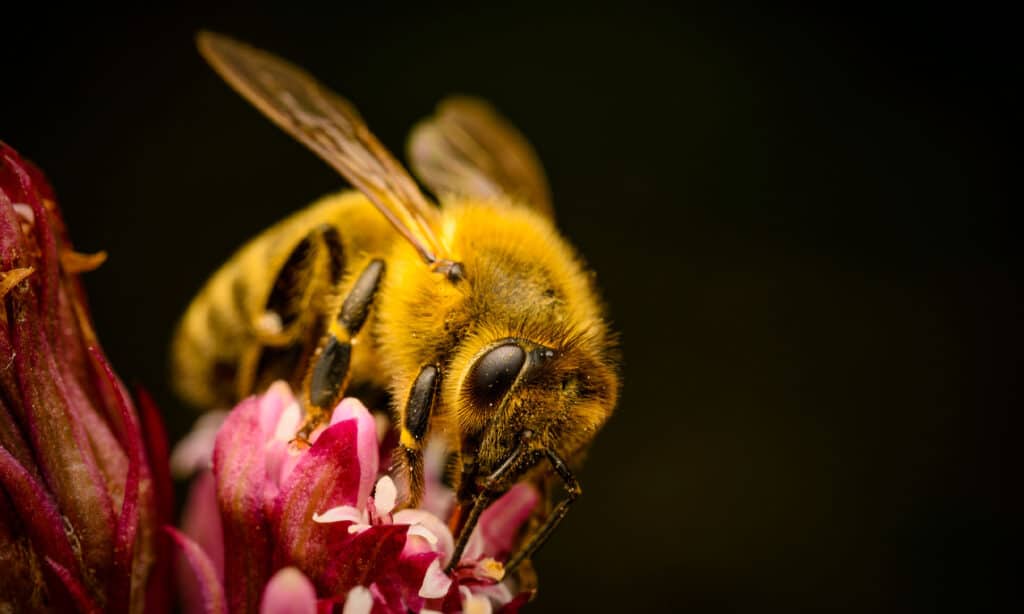
The European (also called western) honeybee is crucial to agriculture because it pollinates the crops.
©iStock.com/Jan Rozehnal
European Honey Bee Anatomy
A European honey bee’s anatomy is a wonder of efficiency and specialization, tailored to the duties and functions essential to its survival and significant pollination role. Honey bees have three basic eyes on top that let them sense light intensity and orientation, and complex eyes on the sides that provide a large range of view. They have antennae, which are essential for interpreting chemical cues, interacting with other bees, and smelling flowers.
On the thorax, bees have three jointed pairs of legs. Bristles and specific structures on the legs, such as pollen baskets on the hind legs, make it possible for them to efficiently gather and transfer pollen. The two sets of wings that are also housed in the thorax enable bees to fly with extraordinary agility and accuracy.
A honey bee’s abdomen is divided into various sections. Along with the stinger, it also houses the reproductive and digestive systems. Only female bees possess the stinger, a modified ovipositor that acts as a defensive mechanism. After being stung, a bee loses its stinger and finally dies because the barbed stinger is still lodged in the victim.
Honey Bee Evolutionary Anatomy
Important changes to the honey bee’s body for gathering pollen and nectar are also present. They have a long proboscis that serves as a tongue-like straw for sucking up nectar from flowers. Mandibles are part of the bee’s mouthparts and are used for things like molding honeycomb and working with wax.
The wax-producing glands on the bottom of their bellies are another unique feature of European honey bee anatomy. These glands allow bees to make wax, which they subsequently shape into hexagonal cells to produce honeycomb structures for holding and caring for young.
It is important to keep in mind that worker bee, drone, and queen anatomy can occasionally vary. Drone bees are bigger with larger eyes and no stingers, whereas worker bees are often smaller and more specialized for duties like foraging. Queens have a very specific build and have the reproductive organs needed to lay eggs.
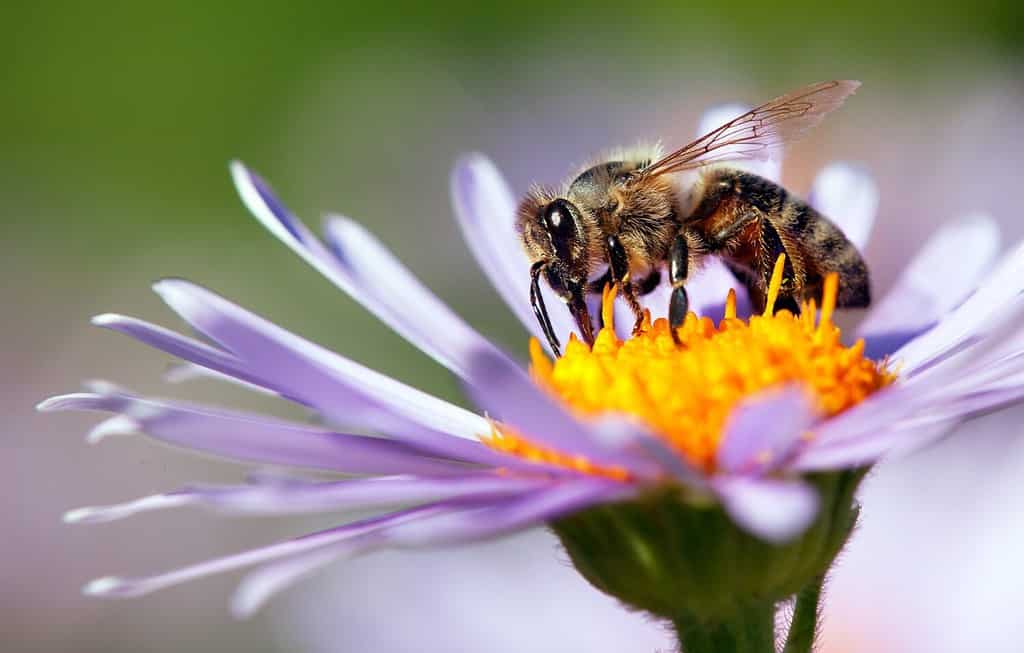
Honeybees possess impressive capabilities, such as the ability to fly at a maximum speed of 15 mph.
©Daniel Prudek/Shutterstock.com
European Honey Bee Behavior
The intriguing and sophisticated behaviors that European honey bees display are crucial to the health and survival of their colonies. Communication, foraging, nest building, brood care, and defense are some of these behaviors.
One of the most important components of honey bee activity is communication. Forager bees communicate to their nestmates the location of abundant nectar and pollen supplies through a series of complex dances known as the “waggle dance.” They enable other bees to explore and find the same resources by communicating information about the location and distance of the food source.
Worker bees must forage in order to survive. In pursuit of nectar, pollen, and water, they leave the hive. Using their lengthy proboscis, worker bees gather nectar and put it in their honey stomach. They have unique bristles on their legs that they use to capture pollen. They go back to the hive and give other workers the nectar and pollen so they can digest and store it.
Building Nests and Performing Duties
Another amazing honey bee habit is building nests. Worker bees create the complex hexagonal chambers known as honeycombs using wax generated from their wax glands. These honeycombs provide a place to raise brood while also acting as containers for nectar, pollen, and honey.
Worker bees perform essential duties, including caring for the brood. They take care of the brood’s growing population, which consists of eggs, larvae, and pupae. In order to provide the best circumstances for the brood’s growth and development, worker bees control the temperature in the hive by fanning their wings to cool or warm the brood. Additionally, they provide the brood with royal jelly, a unique secretion that is essential for the growth of queen bees.
In honey bee colonies, defense is another key behavior. Worker bees may sting to defend their colony if they feel threatened. When a honey bee strikes, its barbed stinger becomes stuck in the target’s skin, leading to the bee losing its stinger and eventually dying.
Pheromones assist control colony activity and preserve social cohesiveness. They play a significant role in honey bee behavior coordination. The queen bee and other worker bees release pheromones, which have an impact on activities including caring for the brood, foraging, and caring for the queen.
European Honey Bee Life Cycle
The life cycle of the European honey bee involves several phases from egg to adult. The honey bee colony’s survival and operation depend on this life cycle.
The queen bee lays eggs to start the life cycle. Unfertilized eggs grow into male bees known as drones, while fertilized eggs mature into female worker bees or prospective queen bees. The eggs, which are as little as grains of rice, are laid in individual honeycomb cells.
Larvae develop from the eggs after around three days. The larvae are fed royal jelly, a nutrient-rich material made by worker bees. For a few days, worker larvae are fed royal jelly; after that, they switch to a combination of royal jelly and pollen or honey. A larva that is chosen to become a queen, on the other hand, is fed exclusively royal jelly going forward. This diet causes it to mature into a reproductive queen bee.
Honey Bee Molting Process
The bees molt multiple times throughout the larval stage as they develop quickly to meet their expanding size. The larvae transition into the pupal stage by wrapping themselves in silken cocoons. The metamorphosis from larva to adult takes place inside the cocoon. The growth and differentiation of organs, wings, legs, and other bodily components are all a part of this metamorphosis.
The adult bees emerge from their cocoons after 12 to 14 days for worker bees and a little longer for drones. Their exoskeleton hardens as they munch their way out of the wax cells. The newborn bees start out fuzzy and lighter in color, but after a few days, they darken and develop into fully grown bees.
Worker bees perform a variety of duties for the colony, including cleaning, caring for the young, making honeycombs, foraging, and protecting the hive. The main job of drones is to mate with a virgin queen from a different colony, which increases the genetic variety of the honey bee population.
Within a few days of emerging, the queen bee, the colony’s reproductive engine, sets off on her mating flights. She returns to the hive after a successful mating, where she starts her lifelong job of producing eggs to maintain the colony.
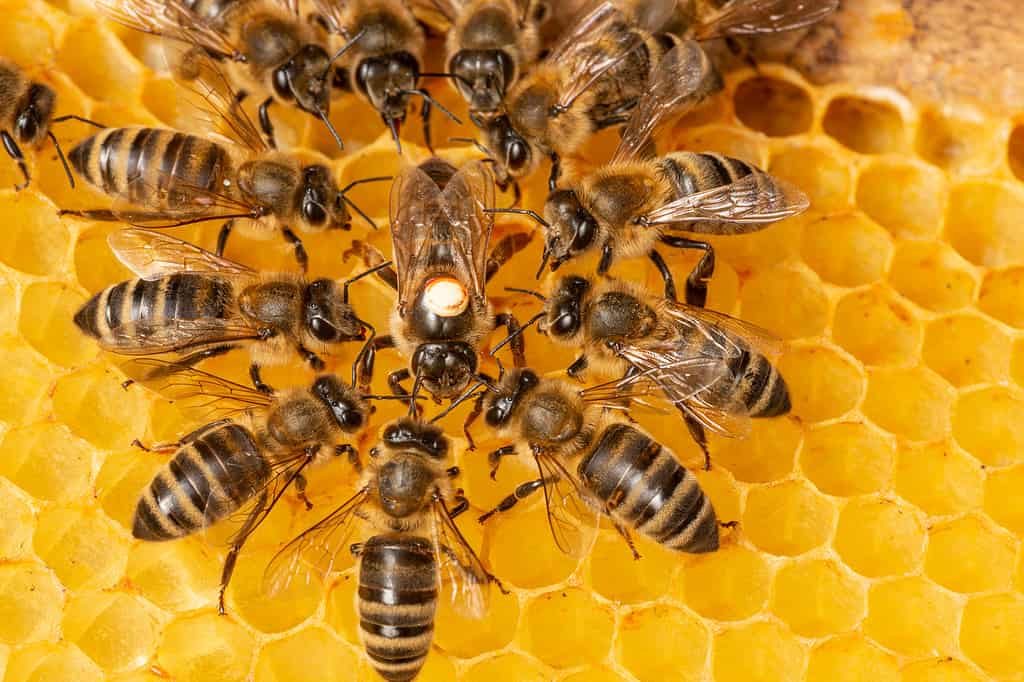
The queen European honey bee (pictured) has a notably different anatomy than the rest of the colony.
©Kuttelvaserova Stuchelova/Shutterstock.com
European Honey Bee Diet
For honey bees, nectar is their main source of carbohydrates. Flowers release nectar, a sweet liquid, to entice pollinators. Bees use their lengthy proboscis, which resembles a straw, to gather nectar and store it in a separate honey stomach from their digesting stomach. They regurgitate the nectar and place it in the honeycomb cells once they are back in the hive. The nectar is subsequently converted into honey by worker bees fanning their wings to remove surplus water. Honey is a concentrated energy source that the colony uses as long-term food storage.
Honey bees also need a diet high in protein, which they get from pollen, in addition to nectar. Essential vitamins, minerals, and amino acids can be found in pollen grains. Worker bees use their bristly legs to gather pollen, which they then carry back to the hive in pollen baskets on their rear legs. Pollen is stuffed into cells close to the honeycomb at the hive to create bee bread. In order to ferment pollen and increase its nutritional content and digestibility, worker bees combine it with nectar, enzymes, and other ingredients.
The Value of Nectar and Pollen
Honey bees receive the vitamins, minerals, lipids, proteins, and carbohydrates required for their life and general well-being from the mixture of nectar and pollen. The development and lifespan of individual bees as well as the efficient raising of broods depend on the balance of these nutrients.
Another crucial element of the honey bee’s diet is water. Bees take water from ponds, streams, and even water droplets on plants, among other places. They utilize water to hydrate themselves, cool the hive, and dilute honey before eating it.
The food of European honey bees and their function as pollinators are closely related. Bees unintentionally move pollen grains from one bloom to another as they search for nectar and pollen, promoting plant reproduction. So, to put it simply: honey bees need food, and this need leads to vital plant pollination.
European Honey Bee Habitat
Due to their remarkable adaptability, the West Virginia state insect can live in a wide range of settings across the globe, including West Virginia. They often reside in locations that offer a wide variety of blooming plants to collect nectar and pollen. Honey bees flourish in landscapes with a wide variety of flowers, such as meadows, fields, orchards, gardens, and woodlands.
Honey bees can be found all across West Virginia, where they make use of the abundant floral resources. They are particularly common in agricultural areas since they are essential for pollinating crops like apples, berries, and pumpkins. Just as well, honey bees are found in West Virginia’s natural ecosystems, which include open meadows with wildflowers and woods with a variety of understory plants.
Honey bees are not restricted to any particular environment, and they may build colonies in both rural and urban areas. They may thrive in a variety of habitats as long as there are enough blooming plants and appropriate nesting locations. Because of their adaptability, honey bees can flourish in both natural settings and environments that have been altered by humans, which makes them a familiar sight in many parts of West Virginia.

Because the European honey bee (pictured) is so common, it is also the state insect of Arkansas, Georgia, Kansas, and several other states.
©SanderMeertinsPhotography/Shutterstock.com
Why is the Honey Bee the West Virginia State Insect?
The honor of being the recognized and official West Virginia state insect belongs to the European honey bee. This selection is evidence of how important honey bees are to the environment, economics, and cultural legacy of the state.
The European honey bee’s crucial function as a pollinator is one of the main reasons it was chosen as the state insect. A wide variety of plant species, including numerous wildflowers, fruit orchards, and agricultural crops, may be found in West Virginia. For these plants to reproduce and produce fruit, honey bees must be used for pollination. Their devoted labor helps the state produce an abundance and diversity of crops, promoting local agriculture and ensuring food security.
Additionally, the European honey bee represents perseverance, teamwork, and community. These are values that the people of West Virginia share. Each honey bee has a distinct job and responsibility inside the hive, and honey bees are recognized for this amazing division of labor. The people of West Virginia, who are renowned for their strong sense of community and work ethic, are reflected in this coordinated and cooperative attitude.
The Contributions of Honey Bees
Another important aspect of the honey bee’s selection as the state insect is its economic contribution to the state. With many beekeepers producing premium honey and associated goods, West Virginia’s honey business is booming. Honey bees help the agricultural industry by making sure that different cash crops, like apples, berries, and pumpkins, are pollinated. Farmers and the local economy immediately benefit from their influence on crop output and quality.
Just as well, honey bees play a significant role in the environment and natural history of West Virginia. By pollinating indigenous plants and sustaining the fauna that depends on them, they play a crucial role in preserving the biodiversity and well-being of the state’s forests, meadows, and natural areas. The honey bee is a real American hero!
The photo featured at the top of this post is © SanderMeertinsPhotography/Shutterstock.com
Thank you for reading! Have some feedback for us? Contact the AZ Animals editorial team.



